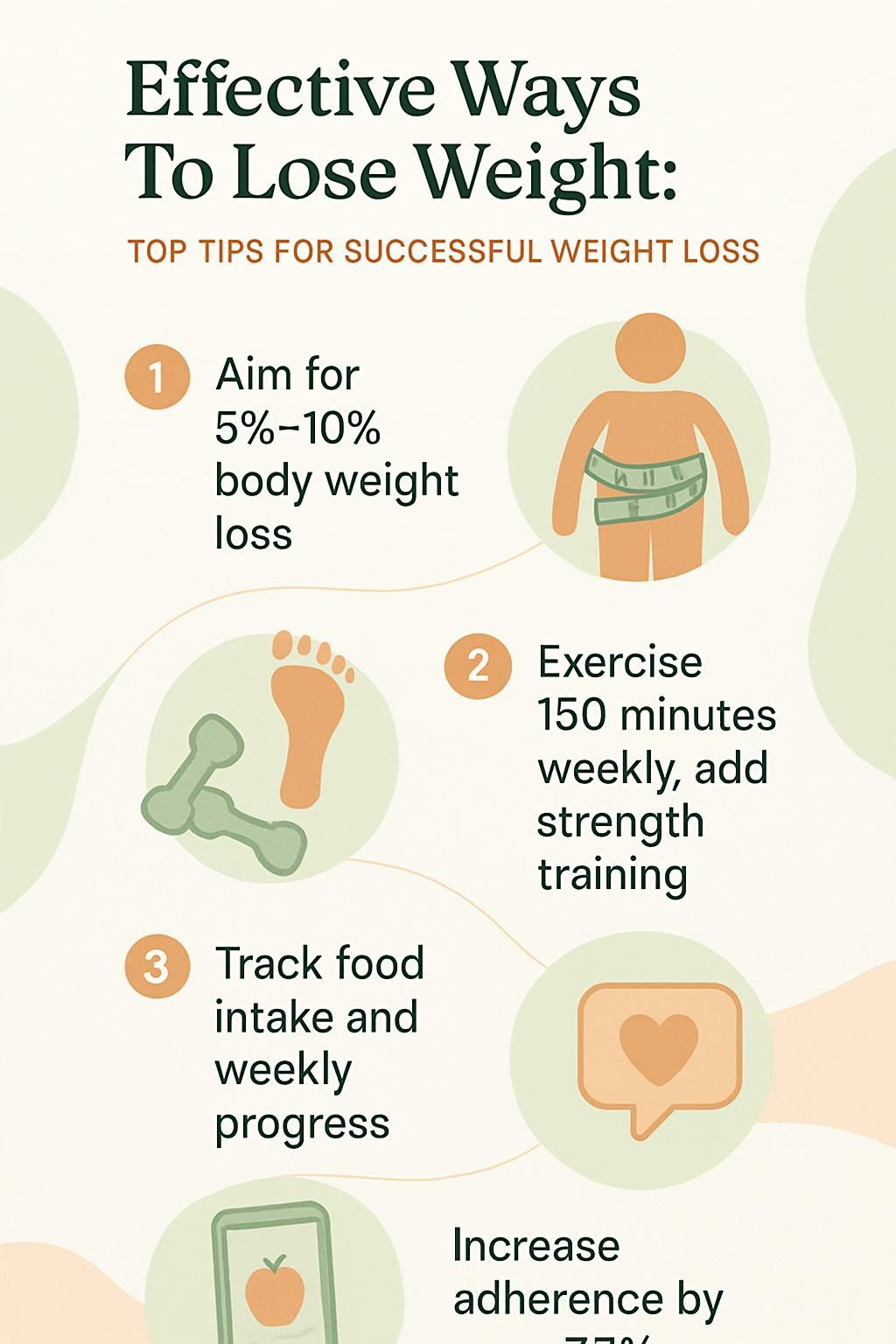Effective Ways To Lose Weight: Top Tips For Successful Weight Loss
Our Nutrition Assistant AI Suite will transform your body. You will lose fat, get toned, and build muscle. Gain confidence and optimal health.
If you want proven ways to lose weight but feel overwhelmed, you are not alone. Even modest weight loss can lower the risk of heart disease and type 2 diabetes.
This guide shares practical steps to help you lose weight and keep it off with healthy eating, steady physical activity, and simple daily habits. Keep reading for clear, science-based tips that fit real life.
Key Takeaways
- Aim for a modest loss of 5% to 10% of body weight. This level often reduces risks linked to heart disease and type 2 diabetes, according to the CDC and Mayo Clinic.
- Focus meals on fruits, vegetables, whole grains, and lean proteins. Cutting processed foods supports gradual fat loss without harsh calorie cuts, as shown in Johns Hopkins research.
- Schedule regular exercise. Target at least 150 minutes of moderate aerobic activity each week and strength training twice weekly, a plan supported by Johns Hopkins Medicine.
- Track food and weekly progress with a journal or an app like MyFitnessPal. Consistent monitoring increases accountability and raises long-term success rates, per the National Weight Control Registry.
- Use social support or structured programs. Group accountability can raise adherence by up to 60%, based on CDC data. Seek professional help if you have chronic conditions.

Key Concepts for Successful Weight Loss

Losing excess weight can improve heart health and reduce disease risk. A healthy diet and regular exercise help you reach long-term weight management goals.
Why is lasting weight loss important?
Lasting weight loss lowers the risk of heart disease, type 2 diabetes, high blood pressure, and some cancers. The Centers for Disease Control and Prevention notes that a healthy weight can also improve energy, breathing, and sleep.
Experts at the Mayo Clinic caution against quick-fix diets because they often cause regain. Building sustainable habits sets you up for better control over time.
I once used crash diets and gained it all back. Slow, steady changes and regular aerobic exercise worked far better than extreme cuts or skipped meals.
Even modest fat loss can lead to meaningful health gains.
What are the benefits of modest weight loss?
Losing just 5% of body weight brings measurable benefits. For someone at 180 pounds, that is about 9 pounds.
Johns Hopkins studies show small losses improve blood vessel function and help arteries relax. You may also sleep better as belly fat goes down.
Risk factors for heart disease, type 2 diabetes, and certain cancers decline with modest loss. Many people see improved cholesterol and blood pressure after dropping about ten pounds.
Simple shifts, like cutting added sugar and processed snacks, help you keep results without harsh diets.
Preparing Yourself for Weight Loss Success
Preparation starts with honest reflection and small steps. A clear plan supports consistent eating and activity routines.
How do I know if I’m ready to lose weight?
You are ready when you are willing to change daily habits and make healthy eating a priority. Consider how you will handle stress with non-food options, like walking or talking with a friend.
Look at your schedule. Make room for meal planning and regular physical activity each week.
List your reasons for wanting to lose 10 pounds or reduce the risk linked to obesity. If emotions drive your eating, plan for support from family, friends, or a dietitian.
If stress makes new routines hard, ask a healthcare professional for help with behavior change and stress management.
How can I define my motivation and intentions?
Write your personal reasons for weight loss and keep them visible. Share your intentions with someone you trust to stay focused after setbacks.
Use a journal, an app, or simple notes to track progress and remind yourself why it matters.
Support raises motivation. Ask loved ones to join walks or help plan balanced meals that are low in calories and high in nutrition.
One researcher put it plainly:
“Personal motivation fuels long-term weight-loss success far more than outside pressure.”
When your motivation is internal, realistic goals feel easier and you can maintain them longer.
How do I set realistic weight loss goals?
Aim to lose 1 to 2 pounds per week. That usually means a daily calorie deficit of 500 to 750.
Start with 5% of your body weight. For a 200-pound person, that first target is about 10 pounds. Pair outcome goals with action goals. Examples include walking 30 minutes daily and eating more fruits and vegetables.
Use a past weight that felt comfortable, not just a BMI chart number. If you consider medication, talk with your doctor or a registered dietitian first.
Dietary Changes for Losing Weight
Food choices play a major role in weight loss. Small, steady adjustments help reduce body fat and improve body composition.
How can I reduce calories with balanced meals?
Cutting calories should not feel like punishment. Balanced meals help you stay satisfied while you eat fewer calories.
- Use 9-inch plates or smaller. Smaller plates limit portions without feeling deprived.
- Fill half your plate with vegetables and add whole grains like brown rice. Dietary fiber helps you stay full.
- Choose lean proteins such as skinless chicken, beans, tofu, fish, or eggs. Protein helps maintain muscle during weight loss.
- Use patterns like the Mediterranean or DASH diet. These emphasize plant foods, healthy fats, and less sodium.
- Limit processed convenience foods high in sugar and unhealthy fats. Swap soda for water or unsweetened drinks.
- Prep pre-portioned snacks like carrots or fruit. Eat slowly to notice fullness cues from your stomach and brain.
- Share entrées or order à la carte when dining out. Enjoy favorite foods in moderation without overeating.
- Track your weight weekly and adjust portions as needed. Consistency supports safe progress.
I followed MyPlate guidelines and lost 20 pounds in four months. I felt satisfied at meals and never starved.
What fruits, vegetables, and whole grains should I eat more of?
Produce and whole grains help reduce calories while giving you key nutrients. They also aid blood sugar control.
- Aim for at least 4 servings of vegetables and 3 servings of fruit daily.
- Favor non-starchy vegetables like spinach, broccoli, carrots, and peppers. They fill you up for fewer calories.
- Add fruits such as berries, apples, oranges, and bananas for natural sweetness and fiber.
- Choose whole grains like brown rice, barley, oats, and whole-wheat bread instead of refined grains.
- Use the USDA MyPlate Plan to structure meals and hit daily targets.
- Pick fiber-rich foods to help reduce deep belly fat over time, based on recent reviews.
- Buy local or fresh options when possible. Fresher foods often retain more vitamins that support heart and blood vessels.
- Limit foods with added sugar. Frequent spikes can hinder progress.
- Include legumes like lentils and black beans with whole grains for extra protein and fiber.
Which lean proteins are best for weight loss?
Lean proteins help preserve muscle and control hunger, which supports fat loss.
- Skinless chicken breast is low in fat and high in protein, about 26 grams per three ounces.
- Turkey breast offers similar benefits and is very low in fat.
- Fish such as salmon or cod provides healthy fats that support heart health.
- Eggs are affordable, high-quality protein with helpful nutrients.
- Beans and lentils offer plant protein plus fiber for fullness.
- Low-fat or fat-free dairy supplies protein and calcium.
- Limit processed meats like sausage or bacon. They are high in saturated fat and sodium.
These choices support healthy eating while you reduce calories.
How do I cut back on processed foods and added sugars?
Cutting added sugar and heavily processed items speeds progress. This step often lowers calorie intake without complex rules.
- Read labels. “Low-fat” items can be high in sugar or refined carbs.
- Limit desserts, candy, sweetened yogurt, and sugary drinks. The CDC reports that Americans average about 17 teaspoons of added sugar daily.
- Skip snacks with trans fats, excess sugar, and high sodium, such as chips and many fast foods.
- Choose fresh produce, whole grains, lean proteins, and nuts over packaged items.
- Cook more at home so you control ingredients. I lost 20 pounds in three months once I planned most meals instead of ordering takeout.
- Drink water or unsweetened beverages. Hydration helps energy and workouts.
- Measure packaged snacks instead of eating from the bag.
- Swap pastries or sweet cereals for oatmeal or eggs at breakfast.
- Plan simple meal prep for the week to avoid rushed, less healthy choices.
These changes reduce calories, support fat loss, and keep your diet nutritious.
How much water should I drink to stay hydrated?
Aim for at least eight cups, about 64 ounces, of water daily. If you exercise more, increase intake to match your needs.
Water supports digestion and metabolism and can help you feel full at meals. Replacing sugary drinks with water removes extra calories that slow progress.
Drinking a glass before eating may reduce hunger and improve portion control. When I switched from soda to water while losing 20 pounds, my energy and appetite improved within weeks.
Exercise Strategies for Weight Loss
Physical activity helps you burn calories and protect your health. Strength training builds muscle, which supports lasting progress.
What is the recommended amount of aerobic exercise per week?
Target at least 150 minutes of moderate aerobic exercise weekly, such as brisk walking, swimming, or cycling. If you choose vigorous activity like running, 75 minutes can work as well.
Experts often suggest 30 to 60 minutes of moderate to vigorous activity on most days. Some people may need more to see larger changes.
Aerobic exercise improves mood, sleep, and blood pressure. Spread workouts across the week so movement becomes part of your routine.
How often should I do strength training?
Do strength training at least two days each week, ideally two to three. Use free weights, resistance bands, or body weight to build muscle.
This plan increases calorie burn and helps you keep muscle during weight loss. If you need help building a routine, ask a registered dietitian or trainer for guidance.
Consistent sessions with recovery time support long-term goals.
How can I find enjoyable physical activities?
Try different activities like walking, dancing, or swimming. People stick to exercise they enjoy.
Invite a friend or join a group for social support. Mixing activities keeps workouts fresh and helps you meet weekly cardio goals.
Sampling new options can reveal what motivates you most.
What simple active habits can I add to daily life?
Small movements add up. These habits raise your daily calorie burn with little planning.
- Take stairs instead of the elevator to raise heart rate and use more muscles.
- Park farther from entrances to add regular steps.
- Stand and walk during TV commercials to cut long sitting time.
- Wear comfortable shoes so you are ready to move more during the day.
- Set reminders to stretch or walk for five minutes every hour.
- Walk or bike short errands within a mile when possible.
- Use a tracker or phone app to monitor steps and stay motivated.
- Practice deep breathing during short breaks to lower stress and support consistency.
These actions are easy to adopt and support steady results over time.
Developing Sustainable Eating Habits
Steady habits make a healthy pace easier. A simple plan helps you measure progress and adjust as needed.
Why is having consistent meal times important?
Regular meal times help control hunger and prevent overeating. A steady schedule supports even energy through the day.
People who follow set meal patterns tend to manage calories better. Planning meals also makes it easier to avoid processed foods and stick with balanced choices.
Skipping meals often leads to intense hunger and poor choices later. A consistent routine is a small step with big payoff.
How can I control portion sizes effectively?
Portion control is a simple way to reduce calories without strict rules. These steps work at home and when eating out.
- Use plates no larger than 9 inches to limit servings.
- Pre-portion snacks and meals, especially when buying in bulk.
- Eat slowly for at least 20 minutes to notice fullness cues.
- Order half portions or share an entrée at restaurants.
- Fill most of your plate with vegetables. Keep high-calorie items smaller.
- Avoid eating straight from packages to prevent mindless snacking.
- Check serving sizes on labels and measure if needed.
These habits support long-term weight loss and set you up for accurate tracking.
How do I monitor my eating habits and activity levels?
Tracking makes patterns visible. That insight helps you improve choices over time.
- Log everything you eat and drink in a journal or app, including snacks.
- Record the time and type of physical activity to see your energy balance.
- Note emotions before eating to spot triggers.
- Review logs weekly to find trends like late-night snacking.
- Track calories in and out to guide better decisions.
- Set reminders so you log items in real time.
- Keep a small notebook in the kitchen for quick notes.
- Research from the National Weight Control Registry links regular monitoring with long-term success.
- Share logs with a dietitian to get tailored strategies.
Consistent tracking supports gradual progress and steady motivation.
Adjusting Lifestyle for Weight Loss
Small lifestyle shifts can make healthy choices simpler. These changes support daily energy and better results.
How much sleep do I need for weight loss?
Get 7 to 9 hours of sleep each night. Adequate rest supports metabolism and helps control appetite.
Poor sleep often raises hunger and cravings. Good sleep also fuels workouts and daily tasks. My cravings dropped and workouts improved once I kept a regular bedtime.
Include sleep in your plan for consistent progress.
What are effective ways to reduce stress?
Lower stress to limit emotional eating. Brisk walking, yoga, and short meditations can reduce cortisol, a stress hormone.
Support networks offer encouragement during tough times. Therapists and dietitians can teach coping skills that keep you on track.
During a busy month at work, I tried 10-minute guided meditations. They helped me avoid cravings and stick with my meal plan.
How can I manage emotional eating triggers?
Track moods in a journal and connect feelings to eating choices. Identifying triggers like stress or boredom makes healthier responses easier.
Try a short walk, call a friend, or practice deep breathing. Mindful eating helps you slow down and check if hunger is physical.
Dietitians or counselors can offer tools and support. In one study, people with support had fewer episodes of emotional eating over six months.
Encouraging Support and Accountability
A strong support system keeps you engaged and focused. Accountability turns intentions into daily action.
How do I build a support network for weight loss?
Ask friends or family to join walks or help plan healthy meals. Share goals with people who encourage you and follow up.
Research shows social support helps you maintain habits and results. Join a walking group or a class to make activity enjoyable and regular.
Group involvement can boost adherence rates, based on CDC data.
When should I consult health experts or dietitians?
Speak with a healthcare professional before major diet or exercise changes, especially if you have diabetes, heart issues, or other conditions. Local clinics and hospitals often offer programs designed for your needs.
Registered dietitians can help with meal planning and portions. Seek expert help if progress stalls or emotional eating is frequent.
Professional guidance protects your health and supports steady progress.
What are the benefits of structured weight management programs?
Structured programs provide guidance, support, and clear steps. Many hospitals and health systems offer free or paid classes focused on safe weight loss.
These programs avoid quick-fix promises. Group settings let you share experiences and learn proven methods each week.
I once joined a clinic program. Reporting my food logs kept me consistent during busy weeks and reduced guesswork.
Tracking Weight Loss Achievements
Regular check-ins keep you focused. Small milestones can lift motivation when progress feels slow.
How do I monitor progress and adjust my plan?
Use data to guide changes. Tracking shows what works and what needs a tweak.
- Track daily calories with an app like MyFitnessPal or Lose It to maintain a deficit.
- Measure BMI and waist weekly. A waist under 35 inches for many women and under 40 for many men lowers risk.
- Notice how clothes fit. The scale does not show every change.
- Log meals and workouts. Review each week to spot plateaus.
- Weigh in at the same time weekly to see trends.
- If progress stalls, adjust calories, vary workouts, or add resistance training.
- Update goals monthly based on results. Aim for steady improvement, not sudden changes.
- Celebrate non-scale wins like higher energy and better sleep.
Small course corrections keep momentum strong.
Why should I celebrate small successes?
Recognizing progress raises motivation and confidence. Rewards like new workout gear or a fun activity can inspire you without using food.
People who notice wins are more likely to stay engaged and push through challenges. Positive feedback helps you stick with healthy habits.
Track progress in simple ways so you can see what is working.
Sidestepping Common Weight Loss Mistakes
A few missteps can slow progress. Learn to spot and avoid them early.
What quick-fix diets should I avoid?
Skip plans that promise rapid loss or require extreme rules. Juice cleanses, detox teas, very low-calorie plans, and single-food diets often cut key nutrients.
Such plans usually lead to regain once you stop. They can also promote skipping food groups or eating under 1,200 calories a day for adults, which is unsafe for most people.
Choose a balanced plan you can keep. Evidence-based programs with gradual change support lasting success.
Why is skipping meals or extreme calorie cuts harmful?
Skipping meals can cause overeating later. Cutting too many calories slows metabolism and can lead to muscle loss.
A safe deficit is often 500 to 1000 calories per day. Larger cuts may cause fatigue, nutrient gaps, dizziness, or poor focus.
I used to skip lunch at work and then binged at night. Regular balanced meals helped me control cravings and kept my energy steady.
How do I focus on steady, consistent improvement?
Set small weekly goals, like three vegetable servings daily or a 30-minute walk. Aim for 1 to 2 pounds per week, not extreme drops.
Track food and activity so you can see trends. When setbacks happen, treat them as feedback and restart the next meal or day.
I once struggled with missed workouts. Short morning walks each weekday rebuilt momentum and led to longer sessions later.
Long-Term Weight Management Techniques
Maintenance is a skill. Keep the habits that helped you lose weight and adjust as life changes.
How do I transition to maintenance after reaching my goal?
Increase daily calories slowly, about 100 to 200 per day each week. Weigh weekly. If your weight climbs, reduce the added calories until you level out.
Keep regular activity and stick with the eating pattern that worked. Continue simple tracking to prevent old habits from returning.
Expect some ups and downs. If stress leads to extra snacking, return to planned meals and workouts right away.
Why is it important to continue healthy eating and exercise?
Healthy eating and regular exercise help prevent regain. Muscle supports your metabolism, so keep strength training in your routine.
A diet rich in fruits, vegetables, whole grains, and lean proteins lowers long-term risks like diabetes and heart disease. People who stay active for at least 150 minutes per week tend to maintain results.
Check in on your habits as your needs shift over time.
How often should I reevaluate my lifestyle choices?
Review your plan monthly or quarterly. Adjust food choices, portions, or workouts based on progress and new goals.
Use guidance from trusted sources such as the CDC and the American Heart Association. Flexibility helps you avoid getting stuck with a plan that no longer fits.
Regular check-ins keep your strategy aligned with your life.
Conclusion
Losing weight takes steady effort and practical habits. Focus on sustainable changes, clear goals, balanced eating, regular exercise, portion control, and stress care. These steps help you lose weight and keep it off.
Lean on support, track your progress, and celebrate small wins. If you have a medical condition, talk with a healthcare professional before changing your diet or activity.
This article is for education only and is not medical advice.
FAQs
1. What are the most effective ways to lose weight based on scientific evidence?
Research shows that combining a balanced eating plan with regular physical activity leads to successful weight loss. Studies from the Centers for Disease Control and Prevention highlight that reducing daily calorie intake, increasing fiber-rich foods like vegetables, and choosing lean protein sources support long-term results.
2. How important is tracking food intake for weight loss success?
Tracking what you eat helps many people stay aware of their habits. A study published in Obesity found those who kept a daily food log lost twice as much body mass compared to those who did not track their meals.
3. Can small changes in lifestyle make a real difference in losing weight?
Yes, making gradual adjustments such as walking more steps each day or drinking water before meals can lead to steady progress over time. For example, I started taking stairs instead of elevators at work; this simple change helped me burn extra calories without feeling overwhelmed.
4. What role does sleep play in achieving healthy body mass reduction?
Getting enough rest supports hormone balance and appetite control according to research from Harvard Medical School. People who sleep less than seven hours per night often experience increased hunger which may hinder efforts toward reaching target goals.
Summary: Combining nutritious eating patterns with consistent movement forms the foundation for lasting results. Tracking intake, making manageable shifts in routine, and prioritizing adequate rest further enhance outcomes supported by credible studies and personal experiences alike.







